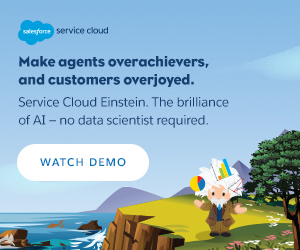This content was produced for Salesforce by the foundry @ MEREDITH CORP. FORTUNETM editorial staff was not involved in its creation or production.
By 2020—just one short year away—some 20 billion devices will be Internet-connected, according to the research firm Gartner. That’s nearly three times as many networked mechanisms as there are people on the planet. Together, linked appliances, tools, and products are forming a vast global web known as the Internet of things (IoT). And with the IoT quickly reaching critical mass, customer expectations are also being propelled into warp speed.
“As IoT devices infiltrate people’s homes and offices, consumers increasingly look for IoT experiences that are monitored, personalized, improved, and updated with new features,” the consultancy company Forrester recently reported. “Customers and employees are wowed by the growing capabilities of web and mobile.”
The implications are major on many levels, but particularly when it comes to the customer experience. When fridges, jet engines, and cargo containers can “talk” to one another—and to companies—they’re creating a wealth of data that translates into true business value. The reason: The information they generate can help organizations gain a deeper understanding of their customers. And with that intelligence in hand, they can deliver more cohesive, personalized service.
A Treasure Trove of Data
Successful firms recognize that digital transformation is Imagine, then, what can happen when companies pool all of the data that IoT devices provide with the information in their existing customer-relationship management (CRM) systems. Making those important connections forms the basis of the latest IoT revolution. Sensors in the gadgets their customers use can reveal so much—and those insights become exponential when they’re placed in context. For one thing, once a business knows where someone bought a particular item, for example—and how long ago—that knowledge can inform how customer service and contact center agents interact with that customer. That makes upselling and cross-selling much easier.
Enterprises can also respond proactively when immediate care is needed, as Paolo Bergamo, senior vice president and general manager of Field Service Lightning at Salesforce recently pointed out. “By the time a customer picks up the phone to report a malfunction, they’re already upset,” he says. “In other cases, they may not even be aware of a problem. But with connected devices sending signals to manufacturers, companies are now able to anticipate and solve problems before customers even know they happened. [And] when IoT is paired with CRM data, a true 360-degree customer view can be achieved, allowing companies to deliver a personalized, consistent, and transformative experience.”
Just as significantly, the connected world of IoT, when enriched with CRM data, makes agents in the contact center personnel and mobile workers more effective, because it gives them a clear window into how customers are using their products. While IoT-connected devices supply the data, the customer needs the right technology to find anomalies and take action on them.
It’s All About the Platform
Successful firms recognize that digital transformation is That’s just a sampling of what’s possible now. Even more applications lie ahead when IoT and CRM software work together.
It’s evident, then, that IoT data can be invaluable to your business, employees, and customers. Keep in mind, though, that data harvesting does not a banquet make. How you prepare the data—how you turn it into actionable insights—is the key to success.
Simply put, to truly pump up the customer experience, you have to select the right platform that can take advantage of what IoT has to offer. The best ones in the current marketplace integrate smoothly with tech tools you likely already have in place. Sophisticated CRM databases, for instance, can associate IoT devices with specific customers and give you insight into how they use them. In that way, you can create device and context profiles to deliver highly personalized experiences. Salesforce IoT—which harmonizes with its CRM products—is one such platform.
Suppose, for example, that a certain item a customer relies on has hit a usage threshold and data indicates that it’s at the end of its lifespan. Your service team can be dispatched to repair it before a problem occurs—a proactive move that will delight your customers and encourage their trust and loyalty. And if the device is on its last legs, field service teams can then recommend a new and better part—another great opportunity for upselling and cross-selling.
Taking advantage of interconnection has never been easier in other ways, too. Today’s IoT platforms have high-level tools that allow you to filter, merge, append, or change data formats as needed. And when you’re ready, you can aggregate and prepare your data for analysis.
With the right tools, you can uncover how consumers use their devices and realize new opportunities that your firm might otherwise have missed. Good IoT platforms make testing out new business possibilities a snap, because you don’t have to be a programmer to try new prototypes. Virtually anyone with a bright idea can have a go.
At the end of the day, then, interconnection gives you real-time opportunities to personalize your response to each customer— and that’s a surefire path to higher profitability. More to the point, though, the IoT universe and an effective platform to leverage it can show you ways to add value for your business, your customers, and—forgive the justified hyperbole—for the world at large.







